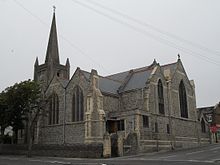St Mark's Church, Brighton
| St Mark's Church | |
|---|---|

The church from the southeast
|
|
| 50°49′03″N 0°06′43″W / 50.8176°N 0.1120°WCoordinates: 50°49′03″N 0°06′43″W / 50.8176°N 0.1120°W | |
| Location | Eastern Road/Church Place, Kemptown, Brighton and Hove BN2 5JF |
| Country | United Kingdom |
| Denomination | Anglican |
| History | |
| Founded | 1838 |
| Founder(s) | Frederick Hervey, 1st Marquess of Bristol |
| Dedication | Mark the Evangelist |
| Consecrated | 21 September 1849 |
| Architecture | |
| Status | Church |
| Functional status | Chapel & Arts Centre of St Mary’s Hall School |
| Heritage designation | Grade II listed |
| Designated | 26 August 1999 |
| Architect(s) | Unattributed; possibly George Cheesman, Jr., Thomas Cooper or Thomas Shelbourne; additions by W. Gilbert Scott |
| Style | Early English Gothic Revival |
| Groundbreaking | 1838 |
| Completed | 1849 |
| Construction cost | £4,800 |
| Closed | 29 April 1986 |
| Specifications | |
| Materials | Stone, ashlar, concrete |
St Mark's Church is a former Anglican church in the Kemptown area of Brighton, part of the English city of Brighton and Hove. Originally intended as the private chapel of the adjacent St Mary's Hall school, it was partly built in 1838 at the request of Frederick Hervey, 1st Marquess of Bristol; but arguments over whether or not it should also be open to the public delayed its completion for more than 10 years. It became the parish church of Kemptown in 1873, but declining attendances resulted in a declaration of redundancy in 1986. At that time it was taken over by the school and became its chapel, nearly 150 years after this was first proposed. The Early English-style stone and concrete structure has been criticised by architectural historians, but has been listed at Grade II by English Heritage for its architectural and historical importance.
Brighton's rapid growth in the early decades of the 19th century resulted in residential development filling in the gap on the cliffs between Thomas Read Kemp's high-class Kemp Town estate and the longer-established area around the Royal Pavilion and Old Steine, the centre of high society activity in the late 18th century. Roads such as Eastern Road and Bristol Road ran from west to east towards Kemp Town, and high-density housing branched off on roads to the north and south. This area became known as Kemptown [sic]. Kemp owned much of the land in the area, but in the 1820s he sold about 150 acres (61 ha) to Frederick Hervey, 1st Marquess of Bristol. He had succeeded to the Earldom of Bristol when his father, the 4th Earl of Bristol (known as the Earl-Bishop), died in 1803. The Marquess, who assumed that title in 1826, was interested in church-building and works of charity. Soon after buying the land, he gave a portion to Reverend Henry Venn Elliott to allow him to build St Mary's Hall School. In 1837, Reverend Elliott began to plan for an Anglican church to serve the area, and the Marquess gave more land next to the school to allow one to be built there. Construction started in 1838, and the Marquess spent about £2,000 (£162,000 in 2017) to ensure a rapid completion. However, disagreements soon arose over these plans: the Diocese of Chichester had not approved the proposal to open the church to the public, and had only given permission for the building to be a private chapel for the school; and the Vicar of Brighton, Reverend Henry Michell Wagner, disapproved of its location—it was considered to be too close to St George's Church. Correspondence and debate carried on for several years between the men involved, and an independent party—the Commissioners for Building New Churches—eventually had to take charge of the project.
...
Wikipedia
